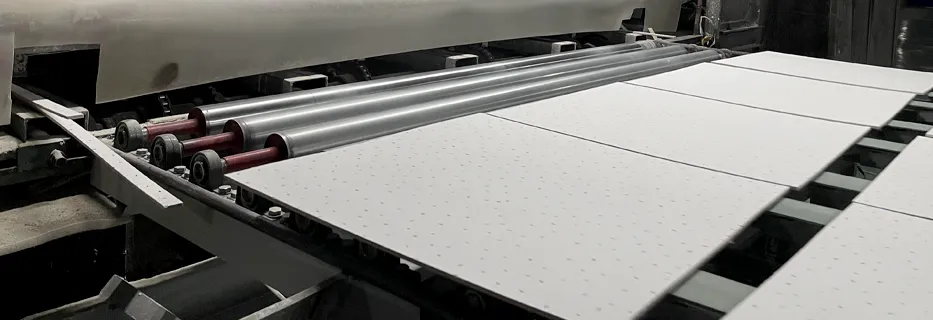Dec . 16, 2024 05:16 Back to list
grid ceiling board
Understanding Grid Ceiling Boards A Comprehensive Guide
When it comes to modern architecture and interior design, aesthetics, functionality, and versatility play essential roles in creating spaces that not only look good but also serve practical purposes. One often overlooked yet vital component of interior construction is the grid ceiling board. This article delves into the significance, types, installation, and benefits of grid ceiling boards in contemporary settings.
What is a Grid Ceiling Board?
A grid ceiling board, also known as a suspended ceiling or acoustic ceiling tile, is an architectural element that consists of a grid framework suspended from the building's structure, covered with ceiling tiles. This system provides an elegant finish to the ceiling and plays a crucial role in soundproofing, insulation, and hiding unsightly elements like wires, pipes, and HVAC systems.
Types of Grid Ceiling Boards
Grid ceiling boards come in various materials and designs, each tailored to different needs and aesthetics
1. Mineral Fiber Tiles These are the most common type of ceiling tiles, known for their excellent sound absorption properties. They are lightweight and easy to install, making them ideal for both commercial and residential spaces.
2. Metal Tiles Offering a sleek, modern look, metal ceiling tiles are durable and easy to maintain. They are often used in high-traffic areas and can reflect light, enhancing the ambiance of a room.
3. Vinyl-Coated Tiles These tiles are resistant to moisture and stains, making them suitable for areas prone to humidity, such as bathrooms and kitchens.
4. Gypsum Boards Known for their fire-resistant properties, gypsum boards are often used in commercial buildings. They can also provide excellent sound insulation, making them a popular choice for offices and conference rooms.
5. Wood Tiles For a more natural and warm aesthetic, wood ceiling tiles are an excellent option. They can add a unique character to a space, although they typically require more maintenance than other materials.
Benefits of Grid Ceiling Boards
Grid ceiling boards offer a myriad of benefits that enhance both the functionality and aesthetics of a space
grid ceiling board

1. Sound Absorption One of the primary purposes of a grid ceiling is to reduce noise. Acoustic tiles can significantly improve sound quality in a room, making them particularly useful in offices, schools, and places of worship.
2. Easy Access to Utilities Unlike traditional ceilings, grid ceilings allow for easy access to electrical wiring, plumbing, and HVAC ductwork. This feature not only simplifies repairs and maintenance but also facilitates future modifications.
3. Energy Efficiency Certain types of ceilings can help improve a building's energy efficiency by providing insulation, which can lower heating and cooling costs.
4. Aesthetic Appeal Grid ceiling boards can transform the look of a room, providing a clean and organized appearance. With various design options available, they can suit any style, from modern minimalist to rustic charm.
5. Safety and Compliance Many grid ceiling tiles, especially gypsum boards, can meet fire safety standards, ensuring compliance with building codes. This is particularly important for commercial spaces.
Installation Process
Installing grid ceiling boards is generally straightforward, making it an appealing option for both professionals and DIY enthusiasts. The process typically involves the following steps
1. Planning and Design Determine the layout, taking into consideration light fixtures, vents, and measurements.
2. Framework Assembly Installing the metal grid involves anchoring it to the ceiling structure, ensuring it is level and secure.
3. Tile Placement Once the framework is installed, the ceiling tiles can be inserted into the grid. This step can vary based on the type of tiles used.
4. Finishing Touches After the tiles are in place, any necessary adjustments can be made, such as cutting tiles to fit around edges or fixtures.
Conclusion
Grid ceiling boards are an indispensable element in today’s building designs. They combine aesthetics with practicality while offering various benefits that cater to both residential and commercial needs. Understanding the types, benefits, and installation processes associated with grid ceiling boards can empower owners and designers to make informed decisions, creating spaces that are not only beautiful but also functional. As we continue to prioritize design and functionality in our built environments, grid ceiling boards will undoubtedly remain a significant component of interior architecture.
-
Durable Ceiling T Grid Systems | Easy InstallationNewsAug.29,2025
-
PVC Gypsum Ceiling: Durable, Laminated Tiles for Modern SpacesNewsAug.28,2025
-
Pvc Gypsum Ceiling Is DurableNewsAug.21,2025
-
Mineral Fiber Board Is DurableNewsAug.21,2025
-
Ceiling Tile Clip Reusable DesignNewsAug.21,2025
-
Ceiling T Grid Modular DesignNewsAug.21,2025







